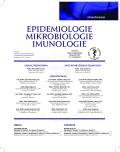Recurrent meningitis and inherited complement deficiency
Authors:
A. Šrotová 1; J. Litzman 2; Š. Rumlarová 3; M. Drahošová 1; D. Bartoňková 2; I. Krčmová 1; A. Roberts 4; S. Jolles 4; P. Králíčková 1
Authors‘ workplace:
Ústav klinické imunologie a alergologie, Fakultní nemocnice Hradec Králové
1; Ústav klinické imunologie a alergologie, Fakultní nemocnice u sv. Anny a Masarykova univerzita v Brně
2; Klinika infekčních nemocí, Fakultní nemocnice Hradec Králové
3; Immunodeficiency Centre for Wales University Hospital of Wales Cardiff, UK
4
Published in:
Epidemiol. Mikrobiol. Imunol. 65, 2016, č. 4, s. 238-242
Category:
Original Papers
Overview
Complement deficiency represents 5% of primary immunodeficiencies worldwide. A total of seven patients with deficiencies of the classical complement pathway were reported in the Czech Republic by the end of 2015. Typical manifestations of complement deficiency are recurrent meningitis, other bacterial infections, autoimmunity and kidney disease.
Two case reports are presented of patients with molecularly confirmed C7 (compound heterozygote, c.663_644del in exon 6 and c.2350+2T:>C in intron 16) and C8 (homozygous c.1282C>T in exon 9) deficiency. The first patient had four attacks of meningococcal meningitis and an episode of pneumonia of unknown aetiology in childhood. The second had six attacks of meningitis. He also suffered from recurrent infections (otitis media, tonsillitis, chronic mucopurulent rhinitis and subsequent pansinusitis complicated by nasal polyposis) since childhood. No autoimmune disease was documented in either patient. They both received meningococcal and pneumococcal vaccines. Antibiotic prophylaxis was used only in the second patient, leading to a decline in the number of ENT infections.
Complement deficiency should be suspected in patients with recurrent meningococcal infections, especially if combined with other infections caused by encapsulated bacteria or autoimmunity diseases. Prophylaxis with conjugate polysaccharide vaccines is recommended and antibiotic prophylaxis should be considered in individual cases.
KEYWORDS:
complement systém – immunodeficiency – meningitis – invasive meningococcal disease – vaccination
Sources
1. Džupová O, Polívková S, Smíšková D, et al. Etiologie a epidemiologie purulentní meningitidy u dospělých pacientů. Cesk Slov Neurol, 2009; 105(4): 331–335.
2. Janocha-Litwin J, Simon K. Recurrent meningitis – a review of cur-rent literature. Przegl Epidemiol, 2013; 67(1): 41–49.
3. Overturf GD. Indications for the immunological evaluation of pa-tients with meningitis. Clin Infect Dis, 2003; 36(2): 189–194.
4. Dwilow R, Fanella S. Invasive meningococcal disease in the 21st century – an update for the clinician. Curr Neurol Neurosci Rep, 2015; 15(2): 1–9.
5. Turley AJ, Gathmann B, Bangs C, et al. Spectrum and management of complement immunodeficiencies (excluding hereditary angioedema) across Europe. J Clin Immunol, 2015; 35(2): 199–205.
6. Plíšek S, Chlíbek R, Kosina P, et al. Invazivní meningokoková onemocnění. Interní Med, 2011; 13(10): 391–393.
7. Křížová P, Vacková Z, Musílek M, Kozáková J. Invazivní meningokokové onemocnění v České republice – analýza epidemiologické situace a doporučení k vakcinační strategii. Epidemiol Mikrobiol Imunol, 2013; 62(4): 138–147.
8. Jandová Z, Musílek M, Vacková Z, et al. Klonální analýza populace meningokoků z invazivního onemocnění a od zdravých nosičů izolovaných v České republice v období 1971–2014 (květen). Epidemiol Mikrobiol Imunol, 2015; 64(3): 147–152.
9. Křížová P, Kalmusová J, Musílek M, et al. Studie dlouhodobosti a mnohočetnosti nosičství Neisseria meningitidis ve zdravé populaci molekulárně biologickými metodami. Epidemiol Mikrobiol Imunol, 2004; 53 (1): 25–36.
10. Kartusek S, Douda P, Gál P, et al. Dlouhodobé sledování nosičství Neisseria meningitidis v nosohltanu a séroprevalence specifických protilátek u imunizovaných a neimunizovaných osob. Epidemiol Mikrobiol Imunol, 1998; 47(4): 145–149.
11. Virji M. Pathogenic Neisseriae: surface modulation, pathogenesis and infection control. Nat Rev Microbiol, 2009; 7(4): 274–286.
12. Krejsek J, Kopecký O. Klinická imunologie. Hradec Králové: NUCLEUS; 2004.
13. Modell V, Gee B, Lewis DB, et al. Global study of primary immunodeficiency diseases (PI)-diagnosis, treatment, and economic impact: an updated report from the Jeffrey Modell Foundation. Immunol Res, 2011; 51(1): 61–70.
14. Babovic-Vuksanovic D, Snow K, Ten RM. Mannose-binding lectin (MBL) deficiency. variant alleles in a midwestern population of the United States. Ann Allergy Asthma Immunol, 1999; 82(2): 134–138.
15. Fukumori Y. A high incidence of C9 deficiency among healthy blood donors in Osaka Japan. Int Immunol, 1989; 1(1): 85–89.
16. Litzman J, Freiberger T, Bartoňkova D, et al. Early manifestation and recognition of C2 complement deficiency in the form of pyogenic infection in infancy. J Paediatr Child Health, 2003; 39(4): 274–277.
17. Athwood JT, Williams Y, Feighery C. Impaired IgG responses in a child with homozygous C2 deficiency and recurrent pneumoccocal septicaemia. Acta Paediatr, 2001; 90 (1): 99–101.
18. Hussain A, Prasad K, Bhattacharyya D. C2 deficiency primary meningococcal arthtritis of the elbow by Neisseria meningitidis serogroup Y in a 12-year old girl. Infection, 2007; 35(4): 287–288.
19. Gaschignard J, Levy C, Crabieh M, et al. Invasive pneumococcal disease in children can reveal a primary immunodeficiency. Clin Infect Dis, 2014; 59(2): 244–251.
20. Grumach AS, Kirschfink M. Are complement deficiencies really rare? Overview on prevalence, clinical importance and modern diagnostic approach. Mol Immunol, 2014; 61(2): 110–117.
21. Kvalsvig AJ, Unsworth DJ. The immunopathogenesis of meningococcal disease. Clin Pathol, 2003; 56(6): 417–422.
22. Lewis LA, Ram S. Meningococcal disease and the complement system. Virulence, 2014; 5(1): 98–126.
23. Křížová P, Musílek M, Vacková Z, et al. Sekvenační analýza antigenů zařazených v čtyřkomponentní vakcíně proti meningokoku B v českých izolátech Neisseria meningitidis v období 2007–2013. Epidemiol Mikrobiol Imunol, 2014; 63(1): 61–68.
Labels
Hygiene and epidemiology Medical virology Clinical microbiologyArticle was published in
Epidemiology, Microbiology, Immunology

2016 Issue 4
Most read in this issue
- Prevalence of Mycoplasma hominis and Ureaplasma urealyticum in women undergoing an initial infertility evaluation
- IGRA methods in the routine operation – QuantiFERON®-TB Gold or T-SPOT.TB?
- Epidemiological significance of the metabolic syndrome
- Differential diagnosis of the viral etiology of suspected mumps in a population with high vaccine coverage
